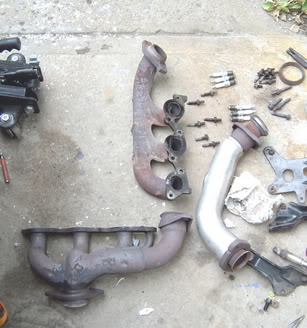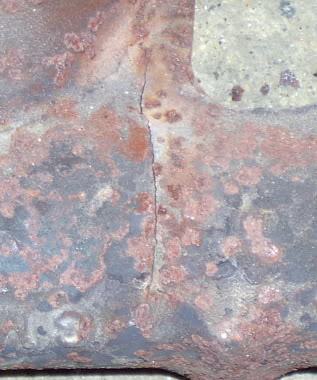Help interpreting scan tool data
#21
Senior Member
True Car Nut
smoking it would be a good test. hit it with some seafoam, kill 2 birds with one stone. just dont let the smoke get in your eyes, thats not pretty 

#22
Junior Member
Posts like a Ricer Type-R
Jolly, that'* not the type of smoke we're referring to. Heating and Air Conditioning techs use smoke to determine where leaks or currents may be. It can be tough on a car with a belt and pulleys spinning, but it can be done if you know what you're looking for.
Ultimately, Seafoam too often will clog your cat.
Ultimately, Seafoam too often will clog your cat.
#23
Senior Member
True Car Nut
Thread Starter
Originally Posted by willwren
The cracked manifolds or exhaust leak will be REAL KR. But with the frequency you're getting a lifter could be the cause for false. Your thoughts on a piston pin (the pin holding the rod to the piston itself) could have merit, as on the L27 and L36, they're floating pins, where on the L67 they have bearings. There'* so many things, you're not likely to narrow it down unless you get the stethescope out. And I'd use a real mech'* scope, not a screwdriver for this one.
Do me a favor to rest my mind. On a COLD engine, before you fire up, spray some soapy water on your manifolds and heads. ALOT. While it'* wet, fire it up and look for bubbles. use a 50/50 mix of dish soap and water. You have to be quick before it starts to heat up and evaporate. Try to rule out an exhaust leak first.
But in the long run, if you HEAR something, odds are the knock sensor can too. I have to trust your ear on this one. If you hear something, odds are it'* false. If you don't, it'* got to be real. This will determine where you look for the problem.
If you think it'* a lifter, try a bit of diesel or marvel mystery oil in your engine oil to thin it out some. Any lifter clatter should go away temporarily.
Do me a favor to rest my mind. On a COLD engine, before you fire up, spray some soapy water on your manifolds and heads. ALOT. While it'* wet, fire it up and look for bubbles. use a 50/50 mix of dish soap and water. You have to be quick before it starts to heat up and evaporate. Try to rule out an exhaust leak first.
But in the long run, if you HEAR something, odds are the knock sensor can too. I have to trust your ear on this one. If you hear something, odds are it'* false. If you don't, it'* got to be real. This will determine where you look for the problem.
If you think it'* a lifter, try a bit of diesel or marvel mystery oil in your engine oil to thin it out some. Any lifter clatter should go away temporarily.
Great idea about the soap. Will do this first thing in the AM. If nothing there, I will pull the knock sensors and re-torque to 14 ft-lb as Foghorm suggested.
I sure appreciate the help, guys.
#24
Senior Member
True Car Nut
Thread Starter
Originally Posted by willwren
Bill,
The RTV will not reduce the sensors sensitivity unless you entirely coat it with the stuff. On the threads is fine, and preferred. You need SOMETHING there to make sure any movement of the sensor to the block will not be interpreted as knock. The knock sensors listen for knock through the coolant. As long as the END or face of the sensor is clean, use whatever you prefer on the threads.
It might be interesting to disconnect them one at a time for back to back scans.
Might help isolate the problem to the front or rear sensor or to the front or rear bank for false KR.
The RTV will not reduce the sensors sensitivity unless you entirely coat it with the stuff. On the threads is fine, and preferred. You need SOMETHING there to make sure any movement of the sensor to the block will not be interpreted as knock. The knock sensors listen for knock through the coolant. As long as the END or face of the sensor is clean, use whatever you prefer on the threads.
It might be interesting to disconnect them one at a time for back to back scans.

Might help isolate the problem to the front or rear sensor or to the front or rear bank for false KR.
#25
Junior Member
Posts like a Ricer Type-R
Bill, coolant and water are like sound distributors. A grinding bearing in a water pump can be heard as easily at the thermostat housing as it can at the water pump itself, so don't kick yourself over not nailing it the first time with the stethescope. It'* tough. I've been through this type of thing time and time again. In the end, it'* the stethescope that CONFIRMS other troubleshooting, rather than nailing it down by itself.
#26
Senior Member
Posts like a Corvette
Join Date: Jan 2004
Location: Montréal, QC
Posts: 1,374
Likes: 0
Received 0 Likes
on
0 Posts

Originally Posted by willwren
The cracked manifolds or exhaust leak will be REAL KR.
Originally Posted by willwren
If you hear something, odds are it'* false. If you don't, it'* got to be real..
Bill B, I still think the most likely culprit of that noise is exhaust. It'* the single leading candidate that can be confused for valvetrain noise.
Seperately, use anything you like to seal the knock sensors, I prefer GM pipe sealant because it cures faster. Whatever you use, give it time to cure before you refill the coolant and then fire it up. Over torquing them has caused many a grey hair

As a side note, I'm not up on the parameters for your PCM, but you might want to give the MAF sensor a clean with alcohol and a q-tip to ensure it'* clean...just in case it'* not reading all the air correctly.
Cheers,
#27
Junior Member
Posts like a Ricer Type-R
I agree with the crazy  on the exhaust. That'* why I pointed out the cracks, leaks, or restrictions right off. Even the clogged cat is a very likely candidate at this point.
on the exhaust. That'* why I pointed out the cracks, leaks, or restrictions right off. Even the clogged cat is a very likely candidate at this point.
 on the exhaust. That'* why I pointed out the cracks, leaks, or restrictions right off. Even the clogged cat is a very likely candidate at this point.
on the exhaust. That'* why I pointed out the cracks, leaks, or restrictions right off. Even the clogged cat is a very likely candidate at this point.
#28
Senior Member
True Car Nut
Thread Starter
Originally Posted by Foghorn
Bill B, I still think the most likely culprit of that noise is exhaust. It'* the single leading candidate that can be confused for valvetrain noise.
Originally Posted by Foghorn
Seperately, use anything you like to seal the knock sensors, I prefer GM pipe sealant because it cures faster. Whatever you use, give it time to cure before you refill the coolant and then fire it up. Over torquing them has caused many a grey hair 

Originally Posted by Foghorn
As a side note, I'm not up on the parameters for your PCM, but you might want to give the MAF sensor a clean with alcohol and a q-tip to ensure it'* clean...just in case it'* not reading all the air correctly.
Cheers,
Cheers,
#29
Senior Member
True Car Nut
Thread Starter
Went up to Wally World first thing this AM and bought dish soap, sprayer, and batteries for my flashlight to do the exhaust leak check. After several minutes with my mirror and light, I decided the only way to properly examine the manifolds was to remove them. So I did.

Look at what I found on the back side (could not see this on the engine) of the front manifold. Hee hee, Bill and Foghorn were right on the money with this. Kudos, guys!

Even Ben was on the right track with exhaust, though we will have to see if the EGR values change with the new part. Seems everyone had a clue but me!
The plan now is install a junkyard manifold, fire it up and scan for KS counts and KR. If still there, out come the sensors for a gentle re-torque.
More as the story unfolds. Are these guys good or what?

Look at what I found on the back side (could not see this on the engine) of the front manifold. Hee hee, Bill and Foghorn were right on the money with this. Kudos, guys!

Even Ben was on the right track with exhaust, though we will have to see if the EGR values change with the new part. Seems everyone had a clue but me!
The plan now is install a junkyard manifold, fire it up and scan for KS counts and KR. If still there, out come the sensors for a gentle re-torque.
More as the story unfolds. Are these guys good or what?
#30
Guest
Posts: n/a
Bill it looks like the exahust gaskets for cylinder 3 and 5 were also leaking.... I can see the carbon tracking on the front manifold face...
Let us know how it goes when you get the new( used ) manifold installed...
__________________
Best Car Insurance | Auto Protection Today | FREE Trade-In Quote
Let us know how it goes when you get the new( used ) manifold installed...
__________________
Best Car Insurance | Auto Protection Today | FREE Trade-In Quote


